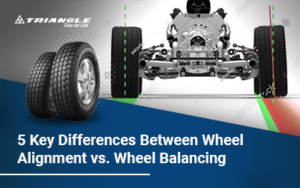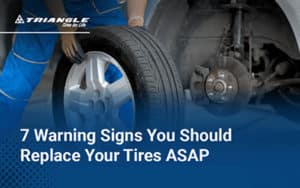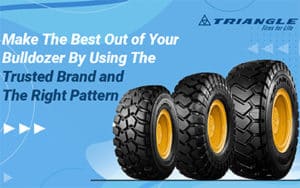Have you ever glanced at your tires and noticed strange indentations forming along their surface? Perhaps you’ve wondered what could be causing those unusual patterns. This common issue may be tire cupping, a relatively unnoticed auto problem.
Tire cupping can be both perplexing and potentially hazardous if left unattended. But fear not! This blog post explores tire cupping: what it is, how to recognize it, and the necessary steps to resolve it. So, get ready to learn about this tire trouble, and don’t let it disrupt your smooth ride!
What is Tire Cupping?
Tire cupping, or scalloping, is damage characterized by irregular indentations or patches along a tire’s surface. These marks create uneven high and low points on the tread, compromising the tire’s smooth and uniform contact with the road.
Tire cupping can significantly affect driving and safety. Inconsistent contact can result in vibrations, decreased control, and rough handling. It can also reduce braking efficiency and traction and increase the risk of hydroplaning.
What Causes Tire Cupping?
Several factors can contribute to the formation of these tire patches, and it’s crucial to understand each one to keep your wheels in good condition.
1. Worn-out suspension
Suspension parts, such as shocks, struts, and springs, are necessary to maintain the tire’s contact with the road surface. However, a worn-out suspension system can significantly impact tire wear patterns and, in severe cases, cause cupping. When your car’s suspension components wear out, they fail to provide proper support and damping, leading to cupping.
2. Misaligned tires
Improper wheel alignment is another common cause of tire cupping. Misalignment occurs when the angles of the wheels deviate from the manufacturer’s specifications. Typically, sudden shocks cause this issue, like hitting a pothole or curb. Misaligned tires experience uneven wear, which can lead to cupping.
3. Unbalanced tires
Balanced tires distribute your vehicle’s weight evenly across the assembly. Accumulated wear and tear can cause your tires’ balance to change, though tread problems can worsen the situation. Once your wheels are off-balance, they are more likely to develop tire cupping due to the uneven wearing of treads.
4. Uneven tire wear
Irregular tire wear patterns, such as feathering, can contribute to cupping. Besides the causes mentioned above, tire pressure problems can also cause uneven wear. It would be best to regularly inspect your tires for any signs of issues and address them promptly to prevent cupping.
5. Low-quality tires
While it’s easy to believe that a wheel is a wheel and tires are all the same, tire quality and construction can vary significantly. Low-quality tires may have inferior tread designs or used compounds, leading to uneven wearing. High-quality tires from reputable brands can help minimize the chances of cupping and ensure better longevity.
Can a Cupped Tire Be Fixed?
Yes, you can fix a cupped tire, but only if you catch it early. Also, a severely cupped tire is a warning sign for tire replacement. Since clear cupping may indicate significant damage to the tire’s structure and integrity, your attempts to fix severely cupped tires may be ineffective and potentially unsafe.
How to Prevent Tire Cupping
Proper maintenance is vital to preventing tire cupping. Follow these best practices to reduce the risk of cupping and extend the life of your tires.
1. Rotate tire positions
Regularly rotate your tires according to your vehicle manufacturer’s recommended interval. This process means swapping your wheels’ positions around. If one corner experiences rougher treatment than the others, you can distribute the wear more evenly across all tires.
2. Check your tires’ air pressure
Maintain the vehicle manufacturer’s recommended tire pressure. Underinflated or overinflated tires can contribute to cupping, so use a reliable tire pressure gauge and check regularly. Don’t forget to include a spare tire, too!
3. Pay attention to your suspension
A well-maintained suspension system is crucial for preventing tire cupping. Regularly inspect and replace worn-out suspension components. Try to notice if your vehicle starts to sag, vibrate, or make noises. When you do, address any issues as soon as possible.
4. Avoid excessive braking and sudden acceleration
Aggressive driving habits, like hard braking and rapid acceleration, can damage your wheels. Practice smooth and controlled driving techniques to minimize unnecessary stress on the tires.
5. Perform regular tire inspections
Routinely inspect your tires for any signs of uneven wear. Look for irregular patterns, bumps, or indentations on the tire surface. Once you notice an issue, consult with a professional for further evaluation. Regular check-ups can prevent problems from snowballing.
The Cupping Conundrum
A safe and smooth driving experience relies on understanding and addressing tire cupping. Try to recognize the causes and symptoms of cupping and implement preventative measures to minimize the risk. Stay vigilant with your inspections and proactively address concerns to conquer the cupping conundrum.
Then, choose quality tires, such as those from Triangle Tires. We have a wide array of tires for passenger cars, light trucks, and heavy equipment vehicles available for delivery at affordable prices. Browse our tire catalog, or contact us today to get started.


